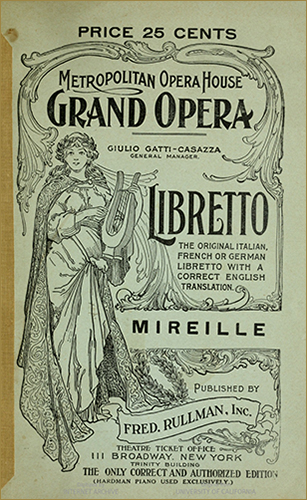40 Occitan

A Lamartine:
Te consacre Mirèio : es moun cor e moun amo,
Es la flour de mis an,
Es un rasin de Crau qu’emé touto sa ramo
Te porge un païsan.
To Lamartine :
To you I dedicate Mirèio: ‘tis my heart and soul,
It is the flower of my years;
It is a bunch of Crau grapes,
Which with all its leaves a peasant brings you. (trans. C. Grant)
On May 21, 1854, seven poets met at the Château de Font-Ségugne in Provence, and dubbed themselves the “Félibrige” (from the Provençal felibre, whose disputed etymology is usually given as “pupil”). Their literary society had a larger goal: to restore glory to their language, Provençal. The language was in decline, stigmatized as a backwards rural patois. All seven members of the Félibrige, and those who have taken up their mantle through the present day, labored to restore the prestige to which they felt Provençal was due as a literary language. None was more successful or celebrated than Frédéric Mistral (1830-1914).
Mirèio, which Mistral referred to simply as a “Provençal poem,” is composed of 12 cantos and was published in 1859. Mirèio, the daughter of a wealthy farmer, falls in love with Vincèn, a basketweaver. Vincèn’s simple yet noble occupation and Mirèio’s modest dignity and devotion mark them as embodiments of the country virtues so prized by the Félibrige. Mirèio embarks on a journey to Saintes-Maries-de-la-Mer, that she might pray for her father to accept Vincèn. Her quest ends in tragedy, but Mistral’s finely drawn portraits of the characters and landscapes of beloved Provence, and of the implacable power of love still linger. C.M. Girdlestone praises the regional specificity and the universality of Mistral’s oeuvre thus: “Written for the ‘shepherds and peasants’ of Provence, his work, on the wings of its transcendant loveliness, reaches out to all men.”1
Mistral distinguished himself as a poet and as a lexicographer. He produced an authoritative dictionary of Provençal, Lou tresor dóu Felibrige. He wrote four long narrative poems over his lifetime: Mirèio, Calendal, Nerto, and Lou Pouemo dóu Rose. His other literary work includes lyric poems, short stories, and a well-received book of memoirs titled Moun espelido. Frédéric Mistral won a Nobel Prize in literature in 1904 “in recognition of the fresh originality and true inspiration of his poetic production, which faithfully reflects the natural scenery and native spirit of his people, and, in addition, his significant work as a Provençal philologist.”2
Today, Provençal is considered variously to be a language in its own right or a dialect of Occitan. The latter label encompasses the Romance varieties spoken across the southern third of France, Spain’s Val d’Aran, and Italy’s Piedmont valleys. The Félibrige is still active as a language revival association.3 Along with myriad other groups and individuals, it advocates for the continued survival and flowering of regional languages in southern France.
Contribution by Elyse Ritchey
PhD student, Romance Languages and Literatures
Source consulted:
- Girdlestone, C.M. Dreamer and Striver: The Poetry of Frédéric Mistral. London: Methuen, 1937.
- “Frédéric Mistral: Facts.” The Nobel Prize. https://www.nobelprize.org/prizes/literature/1904/mistral/facts. (accessed 11/12/19)
- Felibrige, http://www.felibrige.org (accessed 11/12/19)
Title in English: Mirèio / Mireille
Author: Mistral, Frédéric, 1830-1914
Imprint: Paris: Charpentier, 1861.
Edition: 2nd
Language: Occitan with parallel French translation
Language Family: Indo-European, Romance
Source: Gallica (Bibliothèque nationale de France)
URL: https://gallica.bnf.fr/ark:/12148/bpt6k64555655
Other online editions::
- An English version (the original crowned by the French academy) of Frédéric Mistral’s Mirèio from the original Proven̨cal under the author’s sanction. Avignon : J. Roumanille, 1867. HathiTrust
- Mireille, poème provençal avec la traduction littérale en regard. Paris : Charpentier, 1898. HathiTrust
- Mirèio : A Provençal poem. Translated into English by Harriet Waters Preston. London, T.F. Unwin, 1890. Internet Archive (UC Riverside)
Select print editions at Berkeley:
- Mireille : poème provençal. Traduit en vers français par E. Rigaud. Paris : Librairie Hachette, 1881.
- Mireille = Mirèio : poème provençal. Edition illustrée 1914-2014. Cressé : Éditions des régionalismes, 2014.
- Mireille : poème provençal = Mirèio : pouèmo prouvençau. Édition bilingue. Paris: Bernard Grasset, 2017.

